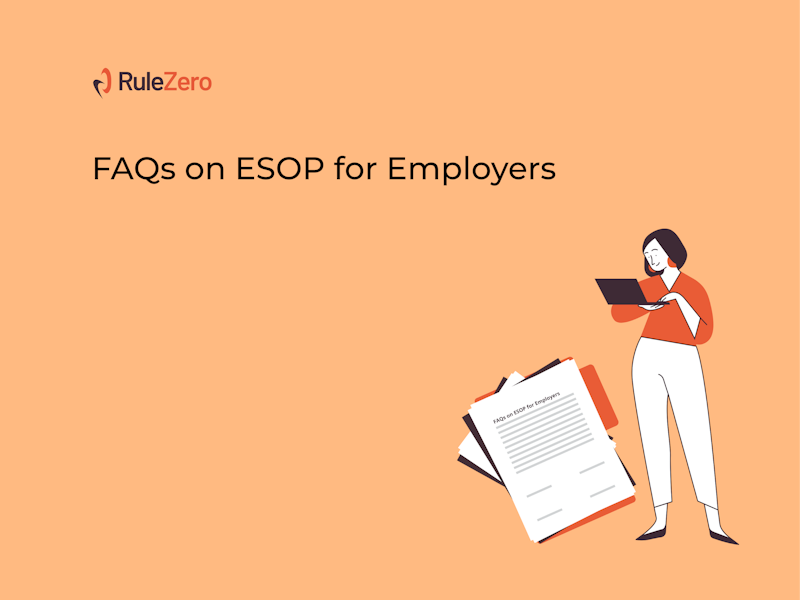Part II of the options series – FAQs on ESOP for Employers, focuses on common questions employers have on stock options.
1. What are stock options? How many types of stock option plans are there?
Stock options are ‘rights’ granted to employees (and not obligations) to acquire the shares of the employer company at a fixed price (or strike price) against satisfaction of some conditions (vesting conditions). While the employee is not bound to exercise the options, the company will be bound to honour the grants as per its terms and conditions.
The different types of stock option plans are:
1. Employee Stock Ownership Plan(ESOP): ESOPs are intended to encourage employees to acquire ownership in the company. Under this plan, employees have the option to purchase the company’s shares in the future at a fixed discounted price. This means, employees can convert their options to shares at a price lower than the existing value of shares, the difference being the reward for the employees.
2. Employee Stock Purchase Plan (ESPP): Employees have the right to purchase the shares of the company at a discounted value. In few companies, an agreed percentage of the employee’s salary is deducted which is then aggregated to buy the company’s stock on scheduled dates in the future.
3. Stock Appreciation rights/Phantom Plans: The options do not convert to shares at a predetermined price. Instead, the employees receive the return either in the form of cash or shares equivalent to how much the stock has appreciated in value between two set dates i.e. the grant data and exercise date. The appreciated value is the difference between the market value of stock and the grant price between these dates.
4. Trust: The company sets up a trust to whom legal ownership of shares is granted. The trust then grants beneficial ownership of the shares to the employees of the company. The trust here acts as an intermediary between the employees and the company to carry out transactions regarding options. On exercising stock options, employees are granted all economic benefits of ownership of shares like the right to receive dividend, vote etc., while legal ownership remains with the trust.
2. What should be the size of the stock option pool? How should one determine the number of options to grant?
At a very early stage, when the founding team is being built, there is no value in the company. There is only a story and a belief in the founders that they can pull off something big. At this stage, everything is discussed in percentage terms. The ideal stock option pool percentage ranges from 5% to 15%.
Many factors go into determining the number of options to grant. These include the seniority, experience, performance of employees etc.
3. What are phantom grants?
In phantom grants (also called Stock Appreciation Rights), the employee gets the economic benefits associated with options but not the right to become a shareholder. The employee is entitled to the difference between the strike price and the fair value of shares (upon vesting). The value of the vested phantom units has to be recorded as a cash liability on the books.
4. Is there any other way of rewarding the employees without actually allotting shares to them?
Yes. This can be done through ESOP Buybacks. Another method is to introduce a plan for Stock Appreciation Rights or Phantom Rights instead of the traditional ESOP plan.
5. What are the different models that should be considered for making grants? What is the difference between each model?
Grants are made under various structures. The commonly used structures in India are:
- Grants that permit exercise at the choice of the grantee (“Free Exercise Plans”).
- Grants that restrict exercise to specified situations – usually M&A, Listing or for providing liquidity to grantees (“Restricted Exercise Plans”).
- Stock Appreciation Rights Plans / Phantom Grants (“Appreciation Rights”).
In Free Exercise Plans, the grantee becomes a shareholder upon exercise. In Restricted Exercise Plans, companies manage the exercise in such a way that the grantee exercises only in relation to a liquidity event for the grantee. This restriction falls away after a listing of shares. When granted Stock Appreciation Rights, the grantee does not have the right to become a shareholder even after a listing of shares. The grantee gets only the economic benefits associated with shareholding.
The other key aspect to note is the taxability for the grantees / employees. In Free Exercise Plans, gains are bifurcated between ordinary income and capital gains – (a) the difference between the strike price and fair value at the point of exercise is considered as ordinary income at the time of exercise, and (b) the difference between the sale price and the fair value at the time of exercise is capital gains (there could be a capital loss as well).
In Restricted Exercise Plans, except following a listing of shares (when options may be exercised), gain is usually considered as ordinary income. In Stock Appreciation Rights plans, the entire receipts by the grantee will be considered ordinary income.
6. Do option plans create any liability or risk for the company?
Stock options are essentially employee benefit plans. The company must provide for the annual estimated expense over the term of the plan. For instance, in Free Exercise Plans and Stock Appreciation Rights Plans, the company must provide for the expense over the vesting period. The expense is calculated as per the prescribed accounting standards. In Restricted Exercise Plans, the expense is booked when there is certainty of the occurrence of the liquidity event.
Free Exercise Plans carry the risk of stake dilution, interference in managerial affairs and the possibility of a hostile takeover. In Restricted Exercise Plans, this risk is crystallized only in the case of a liquidated event. There is no such risk under Stock Appreciation Plans.
There are a number of ways of mitigating the risk like restricting the stock option pool to a small percentage of the post-issue share capital, opting for ESOP buyback at the time of exercise and adequate documentation in the form of accelerated vesting – single trigger acceleration or double trigger acceleration. This ensure that the founders get the benefit of accelerated vesting in unforeseen circumstances.
7. How is the Fair Market Value (FMV) of ESOPs or the underlying shares determined?
FMV of the shares is based on whether or not the shares are listed on a recognized stock exchange in India at the time of exercise. The FMV of listed shares is linked to the market price on the exercise date. In case of unlisted shares, the FMV is calculated by a Merchant Banker.
There are separate regulations for valuation of ESOPs for the purpose of accounting and income tax. Many companies follow the practice of valuing ESOPs annually.
8. Is there any difference from an administrative / management perspective?
Yes.
In Free Exercise Plans, the company will need to treat the grantee as a shareholder and ensure compliance with the applicable regulations. Plans usually provide that options will lapse if an employee leaves employment unless exercised within a defined duration (usually a few months at the most). Given the significant amount of taxes that need to be paid, this becomes a significant retention tool. Employees would rather not want to lose the options or pay taxes upon exercise without clarity on liquidity. Further, the company may become a public company if the number of shareholders exceed 200 (except employees who exercise the options and are issued shares prior to the employment coming to an end).
In Restricted Exercise Plans and Stock Appreciation Rights Plans, the company does not have to worry about shareholder related compliances. However, the company will have to record the value of the vested grants as a liability in its books. This may potentially, affect the solvency of the startup as well.
9. Some companies permit grantees to exercise options at any time, while others don’t - what are the advantages and disadvantages of these models?
In Free Exercise Plans, options can be exercised as per a pre-determined vesting schedule. The employees can exercise the options at their will once the options vest. The option must be exercised during the exercise window.
In Restricted Exercise Plans, the employees have a right to exercise the options only when there is a liquidity event.
A Free Exercise Plan ensures that the employee is entitled to the benefit if he/she exercises the options. However, in Restricted Exercise Plans the benefit is conditional upon the occurrence of a liquidity event.
10. Is there any relaxation on exercise of ESOPs issued by startups?
The employer deducts TDS immediately on exercise of ESOPs. This may lead to a temporary liquidity crunch. To address this anomaly, employees of certain eligible startups are entitled to defer their tax liability. In such cases, tax liability in the year of exercise can be deferred up to the earlier of:
- 4 years from the end of the year in which the ESOPs were exercised,
- The date of sale or
- The date of cessation of employment
11. What happens when the company is acquired?
Typically, when a company is acquired, the management changes hands. In a worse-case scenario, it may result in the ousting of the existing founders or the founders leaving the company for good. To protect the interests of the founders, the documents generally provide for a ‘double trigger’ clause. This clause results in accelerated vesting of the stock options on occurrence of both the events – acquisition of the company and a subsequent termination of employment (voluntary or otherwise) within a specified period of time after acquisition.
12. What are the most common terms that the management has to consider when setting up an ESOP plan?
Since ESOPs involve a number of processes from designing to governance, the following list of questions will help you structure a basic stock option plan.
Instrument Related:
- What is the maximum number of stock options that can be granted to an employee?
- What should be the vesting conditions?
- What should be the exercise price and exercise period?
- How can stock options be exercised?
- Can options be exercised multiple times in a given year?
- Should this be a cash or non-cash exercise?
- How long should the exercise window remain open?
- How will the stock options be valued?
Employee related:
- Who are the eligible employees? What is the criteria for an employee to become eligible to receive stock options?
- How many employees will be covered under the stock option plan?
- In an event of termination, death, incapacity of an employee, how will the stock options be treated?
- Who is liable to pay tax pursuant to exercising the options?
Governance related:
- What internal policies/conditions need to be complied with before granting stock options?
- What documents need to be in place in connection to stock options?
- What should be the percentage of the stock option pool?
- How will the stock option plan be implemented?
- Who is responsible for managing stock options?
- What are the disclosure requirements of the stock option plan?
- How are the unvested options treated?
- How should stock options be treated in an event of merger/amalgamation/ liquidation of the company?
More in this Series
- Part III – FAQs on ESOPs for the Employee
- Part IV – Regulatory aspects of ESOPs
- Part V – ESOPs as a hiring strategy
- Part VI – Wealth creation through ESOPs







